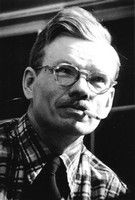Kenneth Stubbs |
 |
Kenneth Stubbs |
 |
|
Two More Stimulating Exhibits[... paragraphs on another show omitted ...] The Society of Washington Artists is holding its annual exhibition at the Arts Club, to run through June 5. Unlike its large show, which is held at the Smithsonian each year and to which all artists are invited to submit work, this smaller exhibition is limited to members only. Most of the artists' names will be familiar to Washingtonians, and the show seems to be a fair cross-section of their work Ralph de Burgos' "Marine Arrangement" is a well integrated abstraction using fish forms in an interplay of angles and flickering shapes within a circular composition. Mimi Bolton's "Lost Lake," which won first prize, is a sensitive study in semi-abstract technique. Jessalee Sickman's "Artist at Work" is a strong, freely brushed figure in the manner of Soutine, with great verve and vitality. Lilla Asher submits a wire construction, "Zebra," with the animal's stripes most amusingly suggested in the twisted wire. Robert Willis' "Mechanical City" is a strongly textured abstraction in red and black. Samuel Bookatz is represented by a long vertical canvas, "Prayer," in his usual competent manner. Among the most interesting of the smaller works is Katherine Stater's "Night Birds and Prophets," a strangely terrifying little study of a huge bird and human figures in subtle blues and greens. Leonard Maurer's "Cathedral," in brilliant colors, has fine textural interest in a well integrated composition. Charles Hoover shows a large portrait of a dreamy-eyed girl called "I Remember," with a subtly evocative quality to the pose. Kenneth Stubbs' "Wharf Still Life" is of brilliant flat patterns based on natural forms. It has great vitality but remains somewhat posterish in its complete denial of texture. Peter Blanc's "Nighthawk" is a fine study which contrasts the strongly curved beak of the bird against the soft texture of the feathers. Leslie Judd Portner, Washington Post, May 18, 1952, page L4
|